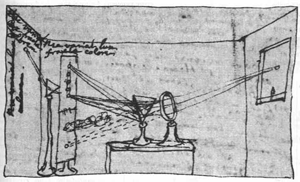In order to gain any sense of how the visual system obtains and interprets information, the nature of the sensory stimulus itself must be pinned down. What is it that we are actually seeing when we gaze upon the world? What physical thing is entering the eye? The answer is light, a physical, quantifiable thing.
Take a look around the room. Energy produced by lighting fixtures in the ceiling, or if you’re lucky enough, from the sun outside a window, is traveling through the room in the form of electromagnetic waves—self-propagating oscillations of perpendicular electric and magnetic fields. Depending on the molecular structure of the objects they encounter, these waves are absorbed or reflected. The reflected light enters your eye, where it is focused on an array of about 125 million photoreceptors in the retina that generate neural responses when their wavelength-specific light-absorbing pigments absorb light. Those signals travel down the optic nerve to the rest of the brain for processing.
Understanding the physical properties of light and how it can be quantified (namely by wavelength/frequency and intensity) is the first step in investigating how the visual system detects light and processes it in a behaviorally relevant fashion.
So, what is light? Light is a traveling wave of discrete packets of energy, or quanta called photons. It can be quantified in terms of its rate of oscillation, called frequency, and is measured in the SI unit of hertz, for which one hertz is equal to one oscillation per second. A given light source may emit light having a spectrum of frequencies which sum to give a single frequency. Frequency is inversely related to wavelength, which is a measure of one wave period—the distance between two adjacent peaks or troughs—measured in meters. Waves emitted by electromagnetic radiation vary in wavelength from very long—power transmissions produce waves of wavelengths greater than the diameter of earth(!)—to very short—gamma rays travel at wavelengths smaller than the radius of a hydrogen nuclei.
The sensitivity of the photoreceptors is limited to an incredibly narrow band of wavelengths within the continuous electromagnetic spectrum (image alongside page…find a good one on google), known as visible light, from about 400 nm to 700 nm. In fact, visible light is visible only because you have receptors sensitive to this region of the spectrum. Some creatures have receptors sensitive to other regions of the spectrum, such as bees, who, unlike humans, can detect ultraviolet light. Flowers pollinated by bees boast striking patterns—bull’s-eyes and landing-strips—visible only to UV sensitive organisms, making a bee’s-eye view drastically different from a human’s.
 Image taken by Norwegian scientist-cameraman Bjorn Roslett, shows an evening primrose flower in both natural and ultraviolet light, revealing a bee’s-eye view (right). (Credit)
Image taken by Norwegian scientist-cameraman Bjorn Roslett, shows an evening primrose flower in both natural and ultraviolet light, revealing a bee’s-eye view (right). (Credit)
|
|
Light can be produced by incandescence—when a material is heated—and by fluorescence, which is achieved by the specific excitation and emission of electrons. Incandescence is a coarser approach to the production of light and the result is an illuminant containing a broad representation of wavelengths. Fluorescence is more specific, resulting in emission spectra containing discrete peaks. Both can be used to make white light:
Light and Color vision
 Recombining the wavelengths of the spectrum with a
Recombining the wavelengths of the spectrum with a
second prism yields white,
as shown by Newton (credit)
Color does not exist outside the brain. It is a mental representation of a calculation the visual system makes in response to the relative activation of three photoreceptors having unique sensitivities. When an object absorbs certain visible wavelengths and reflects others the object is perceived as colored, though
wavelengths themselves are not colored. This phenomenon is known as subtractive color mixing, wherein the color observed is what remains after portions of the illuminant have been subtracted out. The opposite phenomenon is
additive color mixing: when differing bodies of emitted light are mixed, their emission spectra are added together. **(link this color mixing stuff to the color basics page)
A given color perception is context dependent: It depends on the spectral composition of the illuminating light, the composition of the object, the local visual context, and the spatial resolution. All of these issues concern the artist making art and the scientist studying vision. In order to grasp the issues addressed in this course an attention to physics is critical
As you heat up an object, like the metal of an electric stove, the object will emit a color; the color depends on the temperature: the higher the temperature the bluer the color. Careful measurements of the color of black-body radiation has led to a standard nomenclature, the “color temperature” measured in degrees Kelvin, for lamps. The standard lamp for psychophysical experiments is called D65, because it has a color temperature of 6500ºK. Lights around 4000ºK would appear tinged with orange; those of 10000ºK, tinged with blue.
For more information on physics at Wellesley please visit the department website.